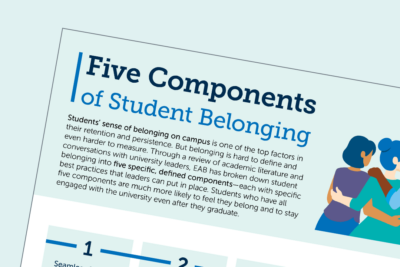3 Timely Financial Aid Strategies to Reduce Student Stress
In this report, learn about how financial aid strategies like bursar hold forgiveness, emergency grants, and merit loss recovery programs can eliminate financial stress for your students.
For today’s students, paying for college is a greater challenge than ever before. After the recession, family incomes still have not recovered. Though more and more students and families are going into debt to cover college costs, many still cannot afford the high price of tuition without additional support.
One in three students who drops out of college does so because of financial stress, according to institutional exit surveys of leaving students and national surveys.
To help students cover sudden funding losses and avoid unmanageable debt, colleges must become increasingly innovative in how and when they offer financial aid. To do so, EAB has identified three best practices to alleviate financial stress, with a focus on the returning students who are too often overlooked.
Practice 1: Bursar hold forgiveness
Most university bursars use registration holds to help make sure students pay library dues, parking tickets, and other bills on time. Unfortunately, these holds often lead students to miss registration deadlines or even drop out of college entirely if they are not caught and resolved in time.
Learn how your institution can create a bursar hold forgiveness policy to help students pay outstanding balances and stay on track to graduate.
Practice 2: Emergency grants
At the typical university, most grant funding and other financial aid is given to first-year students. But evidence suggests that continuing students are even more likely than first-year students to stop out due to financial stress and challenges.
As students advance toward graduation, financial concerns typically intensify. Many continuing students face tuition increases that outpace growth in aid, while others see outright cuts in their packages. Compounding this financial risk is the “sophomore slump” in student engagement, which has been well documented in survey data.
Create emergency grant funding to help these students when they unexpectedly lose funding and need immediate support to cover the gap in tuition.
For first-years, the most significant [attrition] factors are academic in nature. When you look at sophomore leavers, you see a lot more financial factors—unmet need, loan debt, Pell status.
Andrew Morris, AVP for Student Services and Retention
Nazareth College
Practice 3: Merit aid loss recovery
Many states, universities, and foundations require students to achieve a certain GPA to be eligible for grants. However, many students whose GPAs fall below the threshold can still graduate from college as long as they have a way to make up the sudden loss in funding.
See how Georgia State University structured a merit aid loss recovery program to help these students progress towards their degrees and regain their GPA-dependent scholarships.

More Resources

5 components of student belonging

Trends in Student Affairs Responses to Anti-DEI Legislation
